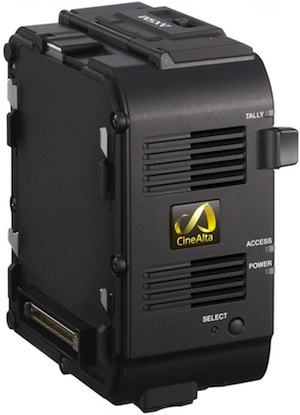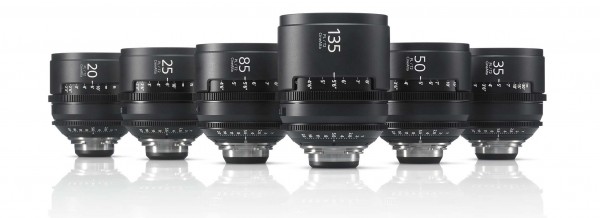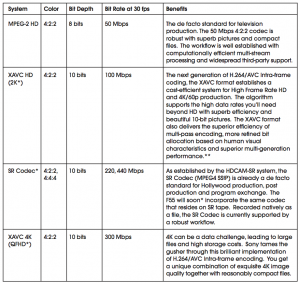Sony F5 and F55 announced
Well it looks like Sony hasn’t been asleep at the wheel after all… truth be told they’ve continuously been releasing some pretty incredible still cameras (Alpha series) and some extremely strong contenders in the video/film business as well (FS 700, FS100 and notably the Sony F3.)
I’ve definitely been watching on the sidelines and none of the video cameras quite got me hooked. But I’d be lying if I didn’t say this new crop of cameras didn’t immediately get my attention.
The specs are perfect on paper and the layout… well it’s very Arri Alexa like to be honest in terms of the button layout.
The package: modular. But most of all – the specs. They’re dead on. Many of the Canon cameras’s specs (the C100, C300, C500) tend to be a bit off in my opinion notably in terms of frame rates and resolution, and notably when you compare them to their pricing relative to what the market has to offer.
While the C-Series from Canon is built around an incredibly impressive sensor, color rendition, and low light performance – I’ve found that the frame rate limitations when combined with price relative to other cameras to be hard to explain at times. Yet to their credit: they cameras are selling well…
Now two things remain unanswered by Sony: what is the price of these two cameras? Philip Bloom has speculated an $18K for the F5 and $50K (body only) for the F55. But that’s only speculation and I don’t like to quote prices unless they come from a trusted retailed or preferably a manufacturer.
The second? Image quality… well, if it’s anything close to (or in between which is very likely) to somewhere in the middle of a Sony F3 and a Sony F65 … then this camera might just make waves.
For now: just the specs please – straight from Sony.
I have to say the ergonomics, modularity, native ISO, and the lens series… are impressive… now we just need to see these in action.
Lastly: man it’s getting tough to be in the cine camera market these days for just about anyone… the heat is definitely on.
Up next on the slate:
Panavision is set to announce their next series of digital cine cameras early next year sometime, rumoured to have multiple digital sensor sizes, including something comparable to 70mm film in size and rez…. the market is getting crowded.
Also of note: RED just announced they would be lowering the price of their Epic cameras given that they have recouped most of the R&D costs… or was it because they knew the Sony announcement was around the corner 😉 Who knows… they definitely beat Canon to the punch when they announced their ($10K) Scarlet ahead of the ($17K) Canon C-300 launch in November of 2012.
I also got to play with the Epic Monochrome this past week. I have to say that if their Dragon sensor (expected early 2013) is anything like what I saw on the Monochrome in terms of low light performance, low noise, and dynamic range… well – let’s just say it’s a whole new ball game once again.
I shot the Epic Monochrome at night in NYC with Canon K35 lenses…. and the last time I had as much fun shooting at night was… well shooting "Reverie" with the Canon 5D MKII 4+ years ago… except this time I was shooting in full RAW and at 5K and in gorgeous black and white… wow. This is becoming a hackneyed saying: but damn it’s a good time to be a filmmaker!
So the specs, from Sony:
Sony PMW-F5 and PMW F55.
Both come equipped with Super 35mm CMOS 4K sensors – 8.9 million effective pixels. Both allow for 16-bit recording (via an external recorder – the AXS-R5 recorder). The F55 however has a global shutter, and should have a higher color gamut, slier to the F65.
Both cameras super sample the 4K Sensor to give you the follow recording options with no crop factor:
SONY F5:
The following all record internally to Sony’s SxS Media. (Click image b slow for full size chart):
Frame rates:
- 60 fps out of the box (XAVC HD).
- 120 fps with a planned upgrade (XAVC 2K/HD). Unique to this process, there is no line skipping or sensor windowing. So there’s no crop factor, no loss in angle of view.
- 120 fps 2K RAW, with the optional AXS-R5 outboard recorder and a planned upgrade, achieves high frame rates while retaining exceptional, 16-bit image quality. This not only ex- ceeds 12-bit RAW with 16 times as many Red, Green and Blue gradations. By design, it exceeds the capabilities of human vision!
SONY F55:
The following all record internally to Sony’s SxS Media. (Click image b slow for full size chart):
Frame rates:
- 60 fps out of the box (XAVC HD at launch; XAVC 4K, QFHD and 2K with a planned upgrade)
- 180 fps with a planned upgrade (XAVC 2K/HD). Unique to this process, there is no line skipping or sensor windowing. So there’s no crop factor, no loss in angle of view.
- 240 fps 2K RAW, with the optional AXS-R5 outboard recorder and a planned upgrade, achieves the highest frame rates most productions will need, while retaining exceptional, 16-bit image quality. This not only exceeds 12-bit RAW with 16 times as many Red, Green and Blue gradations. By design, it exceeds the capabilities of human vision!
Both cameras are also capable of 4K/2K RAW recording via the AXS-R5 external recorder (pictured below):

4K or derived 2K RAW. Capture RAW at your choice of resolutions: the camera’s native 4K or beautiful, derived 2K. RAW recording preserves the greatest latitude for color correction and other post processes.
- Incredible 16-bit precision. By design, Sony’s 16-bit recording captures more tonal values than the human eye can differentiate. Sony RAW retains 16 times as many Red, Green and Blue gradations as 12-bit RAW and 64 times as many tones per channel as 10-bit recording. Sony 16-bit linear RAW is also the ideal point of entry into the 16-bit linear Academy Color Encoding System (ACES) workflow.
- Comprehensive production platform. More than an individual product, the AXS-R5 is the starting point for an efficient workflow. The AXS-R5 records onto sleek, optional AXSMTM memory cards, which are compatible with an affordable optional USB 3.0 reader, the AXS-CR1. Once on a PC, the RAW files can be screened using Sony’s free RAW Viewer software.
- Simultaneous RAW + Onboard SxS recording. Instead of requiring you to patch together a science project, Sony provides a coordinated “off-line, on-line” workflow with simultaneous recording to internal SxS cards and the optional AXS-R5 RAW recorder. For seamless conforming in post, you get matching time code, start frame, stop frame, file names and other metadata. The camera supports the following RAW + Onboard combinations:
SONY F5:
- – 4K/2K RAW + XAVC 2K*/HD
- – 4K/2K RAW + MPEG-2 HD422
SONY F55:
- – 4K/2K RAW + XAVC 2K*/HD
- – 4K/2K RAW + MPEG-2 HD422
- – 2K RAW + XAVC 2K*

MODULARITY
(From Sony): "[Both cameras are] exceptionally small, light and modular, letting you build up the right configuration for each job—or each shot. For example, you can add the optional AXS-R5 RAW recorder whenever you need it. Or go with internal HD recording whenever size and weight are the highest priority. The time code/genlock connections and XLR audio inputs are built into two modules you can add or remove as needed. Small size is particularly welcome in stereoscopic 3D shooting. The chassis is only slightly wider than a typical PL mount prime lens, perfect for both mirror rigs and side-by-side configurations."



















Any comment on the position of the BMC in this raw crowd?
Vincent Laforet Reply:
October 31st, 2012 at 8:48 am
The BMC is one step behind or more at this point as they have just entered the field. Expect their next camera to be a player with my guess of a bigger sensor and full professional features. The BMC ‘s price still can’t be beat and that’s well worth mentioning …
Hi Vincent,
I would hate to be in the camera making game right now. Sony “seem” to have smashed it out of the park with these two cam’s. The thing now is to ‘re-educate’ the market with the new gear.
What is nice, is the ability to scale up or down. PL Glass, Canon, Sony Glass? RAW, or 3 types of SxS codecs. It all looks pretty rosey. I would say that Sony will sell a truck load of these, if they get their pricing right.
And I was ‘Just’ about to buy a C300….
Anyway, keep up the good work mate.
Cheers,
DF ACS.
Thanks for a well balanced review. You’ve managed to share your excitement for the new cameras without losing your head like some other fellow vloggers. The Sony F55 is definitely a great contender and I’m glad that a serious player is now in the 4k affordable market. It would be great if RED could match some of the new features such as global shutter and ND filters. Who knows what Dragon will drop.
I’m really excited to see these new models from Sony. It’s really going to shake up the market, especially for Canon, which is good as I still believe their pricing structure on all their C lineup is more than what it should be (despite them being great cameras to work with). What I’m really interested in knowing is how much all their AXS add-ons will cost; Sony is notorious for charging a ton for their proprietary hardware and media. But in the end, these two cameras from Sony really look like the homework has been done. Good job, Sony!
Vincent Laforet Reply:
October 31st, 2012 at 3:46 pm
Me too! I want to know the cost of everything to have a better picture…
Great preview Vincent, as said above nice balanced piece. It was also good to hear your thoughts on Epic Monochrome- though still on the MX Sensor and aimed more at rental houses and a very niche market it would seem as though RED are working in the right direction with their developments. We’re all headed for an exciting start to 2013 with solid offerings from both these companies, not to mention even more competitive pricing!
I agree with DF. I am relatively new to the “video” game and was just beginning to wrap my head around the Sony workflow. I was just to the point where I understood the XDCAM/MXF HD422 color space etc.
Now with the new formats would you consider doing a workshop explaining what all this stuff means. XAVC HD H.264/AVC Intra-frame. What the??? Is that a rewrapped version of MPEG-4, AVC/H.264 video codec?
Totally lost.
Vincent Laforet Reply:
October 31st, 2012 at 3:45 pm
That’s kind of the problem w/ Sony’s philosophy… they want to give you a COMPLETE solution… you have to use THEIR deck and THEIR cards (that’s my understanding.) A decade ago that used to be very desirable. Now it’s inverted and people want options and to use their EXISTING decks and cards. This will be the major stumbling block for Sony unless they welcome 3rd parties into their workflow IMO.
Vincent, from these specifications, how do you think it compares to the Red Epic? To me it still sounds like the Epic has several stronger features like HDRx, 300fps (2k but not so sharp I guess) and RAW for these modes. However I don’t think the Epic has a 16 bit sensor so that sounds interesting. Other benefits the Sony has is that you dont need the Meizler Module if you are shooting projects with less quality demands. It also sounds nice that they are downsizing from a 8.5MP sensor. Hm, interesting
Vincent Laforet Reply:
October 31st, 2012 at 3:44 pm
The RED looks more full featured and built for cinema and high end shoots for sure. This looks to be at that level and below depending on how you configure it… in the end it’s all speculation until you get to see the image coming off of this thing and the price as well. Red announces their new (lower) price tomorrow as well…
When are we gonna see some of your Epic-M Monochrome/K35 footage? That jumped out to me. I can’t wait.
Vincent Laforet Reply:
November 5th, 2012 at 9:22 am
Not sure – a bit slammed w/ work right now to be honest…
Sorry, but comparing the C-300, which is limited to 8-bit acquisition, even in it’s uncompressed output (which, BTW, is a major point you don’t mention), to one that is likely to be competitively priced with it (the F5) that offers 10-bit, true log recording at much higher bit rates, native 2000 ISO, and RAW recording–in 2K and 4K — is misleading. Thankfully, you mention the C-300’s resolution and frame rate limitations. For all-purpose feature work, particularly G/S, multi-layer FX, shooting w/o lights, etc., log and RAW recording are not minor issues. And yes, I did see Sam Nicholson’s VFX piece on the C-300… not in a theater, on a 50-foot screen… I’m not saying the C-300 is a bad camera. Quite the opposite. It takes very pretty pix, and is easy to use. I’m just saying that Moore’s law is in play here, and the C-300 @ $15K for body only, is done.
Now having said all that, if these new Sony cameras can ONLY record 10-bit and RAW onto Sony’s gear and not 3rd party recorders and/or storage, then that may be their Achilles heel…unless the cost is reasonable enough to swallow.
Awesome insight. These new cameras are very exciting. Can’t wait to see what the next few years brings. Very overwhelming at times. I keep getting caught up in thinking that the cameras are going to get too cheap, and then the market will get flooded. Keep reminding myself its not about the gear.
Vincent Laforet Reply:
November 5th, 2012 at 9:16 am
It’s not about the geat! It’s not about the gear… it’s not about the gear 😉 Eventually it will work if you keep repeating it!
Just curious what your take is on Canons firmware update for the Mark III. It apparently will allow clean 4:2:2 uncompressed HDMI out for external recorders. I was mostly interested on your opinion about mark III picture settings in relation to that and if you think that will make it any more competitive to the BMC.. I know it’s not 12 bit Raw but uncompressed full frame off the sensor sounds interesting. Not sure if the DR limitations are mostly affected by the sensor or compression?
Vincent Laforet Reply:
November 5th, 2012 at 9:15 am
No – I don’t expect it to be competitive in terms of DR to the BMC at all. But the size of the sensor is another big advantage however. 4:2:2: is much better than 4:2:0 compressed… so I’m looking forward to doing tests with it when I can!
@Andreas Oberg,
Just a correction: Epic can record at either 12 or 16bit raw.
I’m looking forward to the first pictures of the new F55. Can not wait. I hope it’s true what Sony promise.
Andreas
Sony’s announcement should leave some cine- and videographers slightly short of choice. In the end, I think, Red will continue to make gains on its niche market. I like the specs of the F5, and if Sony is agreeable I shall be going for it. Better options await in that territory
I just wish Sony would launch this camera with an EF-Mount of their own make, just so you’re sure it works perfectly. Sure, you can go Metabones, but it’s a third-party piece of hardware… I own a load of EF lenses and will not replace them any time soon.
I’ve seen the camera in munich sony roadshow. Nice unit. Sony has forgotten the microphone.
What do you think. Can i use a S-16mm PL Zoom on that camera just to use it for HD/2K ?
Sony electronic EF mount, could be the only thing missing?
The f55 sony was fantastic v.camera.I like it,but how can i found it support me plss,thx
director of photography
AWET SEYOUM